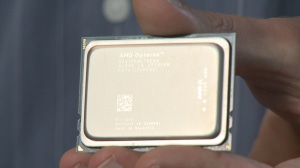AMD is brandishing some big guns. In the server sector, AMD has upped the ante with the "world's first" 8- and 12-core x86 processors. AMD promises their new Opteron 6100 series CPU is going to be blowing rivals (trading under the symbol INTC) out of the water. Is AMD right? Here's some perspective for VARs working in the server sector...
March 30, 2010

 AMD is brandishing some big guns. In the server sector, AMD has upped the ante with the “world’s first” 8- and 12-core x86 processors. AMD promises their new Opteron 6100 series CPU is going to be blowing rivals (trading under the symbol INTC) out of the water. Is AMD right? Here’s some perspective for VARs working in the server sector…
AMD is brandishing some big guns. In the server sector, AMD has upped the ante with the “world’s first” 8- and 12-core x86 processors. AMD promises their new Opteron 6100 series CPU is going to be blowing rivals (trading under the symbol INTC) out of the water. Is AMD right? Here’s some perspective for VARs working in the server sector…
You’re looking at the actual CPU, a rectangular shape that both AMD and Intel have distinctly in their server-end CPUs. But AMD has been looking to do more inside that oblong shape than Intel.
Dubbed the new “Magny-Cours” processor, the Opteron 6100 series has been built from the ground up to “disrupt today’s server economics and provide the performance-per-watt value” that customers are looking for.
I spoke to Brent Kirby, senior product marketing manager for server at AMD. “[We’re working with] customers geared towards performance per watt and expandability.” And that’s what the 6100 delivers, he claims. Each CPU supports either 8 or 12 cores — and the CPUs are supported in 2 to 4 socket server boards.
When talking about performance per watt, the 6100 series actually out-performs Intel’s CPUs at a much lower wattage, AMD asserts. Kirby showed a slide positioning AMD’s 8-core 2.4GHz Opteron against a 6-core 3.33GHz Xeon. The Xeon ran at 130 watts, the Opteron at only 80 watts. In integer throughput, AMD beat Intel by nearly 20% and in floating point performance, nearly 50%, all while being cheaper than Intel’s chip.
Still strolling down Performance Lane, Kirby spoke about “Direct Connect Architecture,” a technology that makes 4 socket board bottle necks a thing of a past. AMD has designed an ability for CPU’s to independently talk to each other (CPU 1 talk to CPU 3), instead of having to loop through (CPU 1 to 2 to 3). Kirby noted that they’ve seen up to a 33% increase in communication speeds since there’s now only one hop between processors.
But the 6100 series isn’t an end in itself, since the socket it uses is built for expansion as. Newer AMD CPUs will support the same socket allowing for a simple swap-and-boot upgradability. Or even now, a solution with 8 core CPUs can be upgraded to 12 core’s later on if server demand gets higher.
“Those same platforms will support next generation processors in 2011 [and for the] past 4 years we had a common socket. We’re putting in place a foundation to do the same thing again.”
Kirby took a poke at Intel while discussing some of the new features of the 6100. All 6100 CPUs support the same features, I/O links and memory speed, etc… but noted that Intel’s CPUs vary on model. Since All of AMD’s platforms share the same chipset and APIs, Kirby noted that drivers, installs and upgrades and tend to be much smooth when compared to an Intel-based solution. Kirby discussed how the Opteron 6100 series supports up to 8 channels and 24 DIMMs while being fully 4-socket scalable, while Intel’s 2-socket solution does not scale and only supports 6 channels, and 18 DIMMs. When pressed about a theoretical limit to the amount of RAM the 6100’s could address, he answered “none,” and suggested 16GB DIMMs could easily be used to fill servers to memory capacity.
“We want to get rid of 4P Tax” Kirby stressed. The 4P or 4-socket tax is a price-tag jump when customers look to buying 4-socket enterprise solutions. AMD has done away with this since the same CPU can be used in a 2-socket or 4-socket board, and that means 4-socket capable CPUs sit at the same price point as 2-socket capable CPUs.
Kirby explained that an AMD top-of-the line 4p solution costs only $1386 while an Intel’x Xeon solution jumps into the $3K level for enterprise 4-socket solutions. (To be fair, Intel offers solutions lower than that in the 4p area, but AMD’s latest solutions don’t break a $2K barrier.)
Lastly, Kirby left me with an interesting features: He noted that in case of PSU failure, the “Magny-cours” will “dynamically tell a server to drop down in power.” You suffer a hit of performance, but the server doesn’t go down and you don’t lose your chips.
So now it’s off to a race of adoption wars. Will AMD’s beefier chip see more use, or will Intel’s familiarity reign despite the new innovations from AMD?
Sign up for The VAR Guy’s Newsletter; Webcasts and Resource Center; and via RSS; Facebook; Identi.ca; Twitter and VARtweet.
About the Author(s)
You May Also Like


